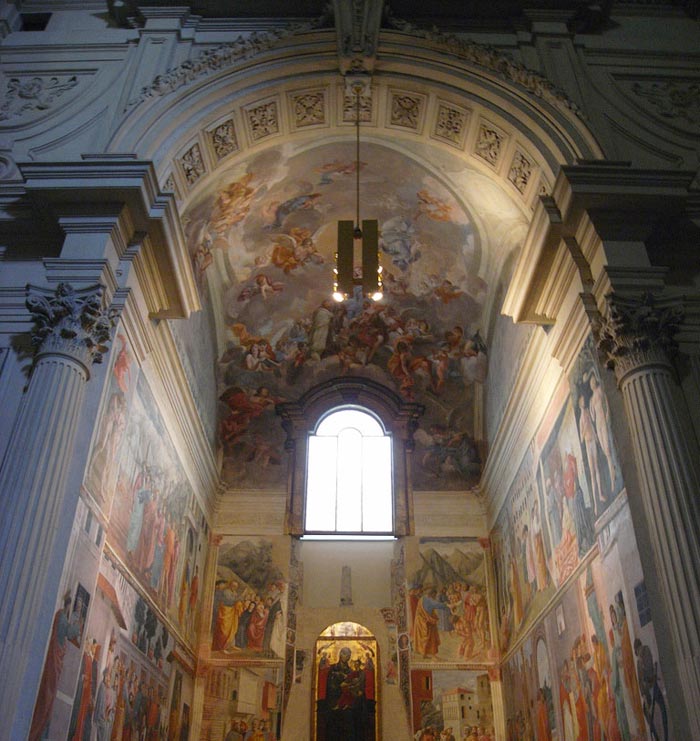 Santo Spirito i Carmine
Santo Spirito i Carmine
A certain idea of the role of the parish church of Santo Spirito is given by the fact, that when in the fourteenth century. Florence was divided into four administrative quartieri, the entire area south of Arno was named after him. A bit dingy Piazza Santo Spirito, with exhibition stands and cafes, and surrounding streets, with furniture factories and antiques exhibition halls, together they embody the character of Oltrarno, character, which has not yet been corrupted by tourism.
Don't be put off by the unattractive facade of the Church of Santo Spirito: interior, one of Brunelleschi's last projects, prompted Bernini to describe it as "the most beautiful church in the world". The proportions are so perfect, that they seem downright vulgar, and yet the plan is extremely sophisticated - a Latin cross with an uninterrupted sequence 38 chapels and 35 columns inside. The main altar is unfortunately covered with a baroque canopy, but this is the only flaw in Brunelleschi's mind. The best paintings are in transepts: in the right is the altar painting by Nerlich by Filippino Lippi, and in the left St.. Monica and the Augustinian Sisters, attributed to Andrea Verrocchio. It is also worth taking a look at the sacristy, which is entered from the vestibule from the left aisle; both rooms were designed by Giuliana da Sangallo in the 15th century.
Fire in 1471 r. he destroyed the entire monastery except the refectory, where the Fondazione Salvatore Romano is now located (wt.-nd. 9.00-13.00; 1000 L, w nd. Free entrance); the collection is worth visiting for the selection of Romanesque sculptures and the enormous fresco of the Crucifixion of the work of Orcagni and his studio.
SANTA MARIA DEL CARMINE
W 1771 r. the fire devastated the nearby Carmelite monastery and its church of Santa Maria del Carmine, but somehow the flames spared Masaccio's frescoes in the Cappella Brancacci, series of paintings, which makes Carmine one of the key Florentine monuments, and recently he provided the Italian art world with a characteristic controversy. Well, the conservation of the frescoes in Carmine began in 1981 r. and a year 1988 it was practically almost finished. In the moment, when these words are written, however, the frescoes remain obscured, because the authorities cannot / decide, whether to remove the baroque altar, which turned out to cover some fragmentary frescoes. Cynics say, that someone takes a big advantage of the delay - that influencers get paid to rent scaffolding and other collateral costs.
The decoration of the Cappella Brancacci began around 1425 r. Masolino, and soon Masaccio joined him as a midfielder. Soon after, the teacher learned from the student, which in terms of feeling the texture of the real world, the principles of perspective and dramaturgy of the illustrated biblical texts far surpassed his predecessors. (Therefore, it is difficult to distinguish in places, what Masolino painted, and what Masaccio - the diagram in the chapel gives, for which areas each of them was responsible). Many earlier artists took up the theme of exile from paradise, but neither has managed to grasp the despair and repentance of the two sinners so clearly. Three years later, Masaccio died, at just the age of 27 years, but - as Bernard Berenson wrote - ,his frescoes have become… a painting school for Florentine artists ". Michelangelo came here to make drawings from the scenes of Masaccio and on one occasion some furious young sculptor broke his nose, unable to bear his condescending behavior. Filippino Lippi finished the series after a sixty-year break, and his most successful contribution is Liberation and. Peter on the right side of the entrance arch.
San Miniato al Monte
San Miniato al Monte's brilliant multicolored façade draws crowds of visitors from the southern shore of the Arno to the hill; have to admit, that the church even surpasses expectations. San Miniato is the oldest church building in Florence after the baptistery and the most beautiful Romanesque temple in Tuscany. The patron of the church, st. Minias, he belonged to the Christian community, who settled in Florence in the 3rd century; legend has it, that they were seen after their martyrdom, how his body lifts his severed head across the river, up the hill to this place, where later a temple dedicated to him was built. The construction of the present building started in 1013 r., with the foundation act of the monastery in Cluny; a marvelous marble façade in its geometric patterns — alluding to the baptistery was added at the end of the 11th century., although the mosaic of Christ between the Virgin Mary and St.. Minias is from the thirteenth century.
An interior with a choir raised on a platform above a large crypt (codz. 8.00-12.30 i 14.00-18.15) unlike any other in town, and its general form has not changed much since the mid-11th century. The main design addition is the Cappella del Cardinale del Portogallo, built at the left aisle as a monument to Cardinal Jacob of Lusitania, who died in Florence in 1459 r. His chapel is a symbol of artistic cooperation - the basic design was made by Antonio Manetti (Brunelleschi's student), the tombstone itself was carved by Antonio Rossellino, and the terracotta ceiling decoration is the work of Luca della Robbia. In the rest of the church one should not miss paviment plates with sophisticated patterns, dated on 1207 r., and the tabernacle between the choir steps, designed in 1448 r. by Michelozza. Most of the frescoes on the walls of the aisles were created in the 15th century.; the most extensive paintings are Scenes from the life of St.. Benedict in the sacristy, made in the eighties of the 14th century. przez Spinella Aretino.